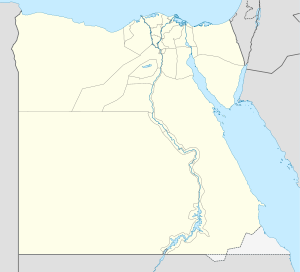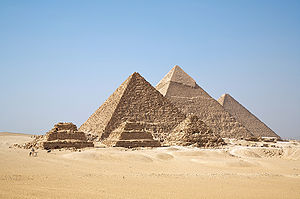Aswan
| Aswan أسوان |
|
|---|---|
 |
|
 Aswan
|
|
| Coordinates: | |
| Country | |
| Governorate | Aswan Governorate |
| Government | |
| - Governor | |
| Population (2008 (estimate)) | |
| - Total | 275,000 |
| Time zone | EST (UTC+2) |
| - Summer (DST) | +3 (UTC) |
Aswan or Aswanl, formerly spelled Assuan, (Arabic: أسوان, Aswān; Ancient Egyptian: Swenet, "Trade"; Coptic: ⲥⲟⲩⲁⲛ, Swān; Ancient Greek: Συήνη, Syene) is a city in the south of Egypt, the capital of the Aswan Governorate.
It stands on the east bank of the Nile at the first cataract and is a busy market and tourist center. The modern city has expanded and includes the formerly separate community on the island of Elephantine.
Aswan is one of the driest inhabited places in the world; as of early 2001, the last rain there was seven years earlier. As of 6 April 2010[update], the last rainfall was a thunderstorm on May 13, 2006. In Nubian settlements, they generally do not bother to roof all of the rooms in their houses.
Contents |
History
| swn.t in hieroglyphs |
|---|
Aswan is the ancient city of Swenet, which in antiquity was the frontier town of Ancient Egypt to the south. Swenet is supposed to have derived its name from an Egyptian goddess with the same name. This goddess later was identified as Eileithyia by the Greeks and Lucina by the Romans during their occupation of Ancient Egypt because of the similar association of their goddesses with childbirth, and of which the import is "the opener". The ancient name of the city also is said to be derived from the Egyptian symbol for trade.[1]
Because the Ancient Egyptians oriented toward the origin of the life-giving waters of the Nile in the south, Swenet was the first town in the country, and Egypt always was conceived to "open" or begin at Swenet. The city stood upon a peninsula on the right (east) bank of the Nile, immediately below (and north of) the first cataract of the flowing waters, which extend to it from Philae. Navigation to the delta was possible from this location without encountering a barrier.
The stone quarries of ancient Egypt located here were celebrated for their stone, and especially for the granitic rock called Syenite. They furnished the colossal statues, obelisks, and monolithal shrines that are found throughout Egypt, including the pyramids; and the traces of the quarrymen who wrought in these 3,000 years ago are still visible in the native rock. They lie on either bank of the Nile, and a road, four miles in length, was cut beside them from Syene to Philae.
Swenet was equally important as a military station as that of a place of traffic. Under every dynasty it was a garrison town; and here tolls and customs were levied on all boats passing southwards and northwards. Around AD 330, the legion stationed here received a bishop from Alexandria; this later became the Coptic Diocese of Syene.[2] The city is mentioned by numerous ancient writers, including Herodotus[3], Strabo[4], Stephanus of Byzantium[5], Ptolemy[6], Pliny the Elder[7], De architectura[8], and it appears on the Antonine Itinerary[9]. It also is mentioned in the Book of Isaiah[10].

The latitude of the city that would become Aswan, located at– 24° 5′ 23″– was an object of great interest to the ancient geographers. They believed that it was seated immediately under the tropic, and that on the day of the summer solstice, a vertical staff cast no shadow. They noted that the sun's disc was reflected in a well at noon. This statement is only approximately correct; at the summer solstice, the shadow was only 1/400th of the staff, and so could scarcely be discerned, and the northern limb of the Sun's disc would be nearly vertical.
Eratosthenes used measurements at Aswan (Elephantine) to contest the Flat Earth theory and tried to determine the circumference of Earth, using Syene as the originating point and Alexandria as the terminal point of a measured arc (based on shadow length at the solstice).
The Nile is nearly 3,000 yards wide above Aswan. From this frontier town to the northern extremity of Egypt, the river flows for more than 750 miles without bar or cataract. The voyage from Aswan to Alexandria usually took 21 to 28 days in favourable weather.
Climate
| Climate data for Aswan | |||||||||||||
|---|---|---|---|---|---|---|---|---|---|---|---|---|---|
| Month | Jan | Feb | Mar | Apr | May | Jun | Jul | Aug | Sep | Oct | Nov | Dec | Year |
| Source: BBC Weather [11] | |||||||||||||
Education
In 1999, South Valley University was inaugurated and it has three branches; Aswan, Qena and Hurghada. It was the first university in Upper Egypt and it was organized in departmental basis. The university grew steadily and now it is firmly established as a major institution of higher education in Upper Egypt. Aswan branch of Assiut University began in 1973 with the Faculty of Education and in 1975 the Faculty of Science was opened. Aswan branch has five faculties namely; Science, Education, Engineering, Arts, Social Works and Institute of Energy. The Faculty of Science in Aswan has six departments. Each department has one educational programme: Chemistry, Geology, Physics and Zoology. Except Botany Department, which has three educational programmes: Botany, Environmental Sciences and Microbiology; and Mathematics Department, which has two educational programmes: Mathematics and Computer Science. The Faculty of Science awards the following degrees: Bachelor of Science in nine educational programmes, Higher Diploma, Master of Science and Philosophy Doctor of Science. Over 100 academic staff members are employed in the faculty.
Transport
Aswan is served by the Aswan International Airport. Train and bus service is also available.
Gallery
|
Archangel Michael's Coptic Orthodox Cathedral, built in the Coptic style |
 The El-Tabia Mosque in Aswan |
 A view along the street connecting railway station and Nile |
 A street parallel to Corniche in Aswan |
|
Aswan |
 The Nile at Aswan, seen from Elephantine Island |
 The Nile near Aswan |
See also
- Abu Simbel
- Aswan Dam
- Elephantine
- Philae
- Luxor
- Kitchener's Island
- Temple of Kalabsha
- Nubia
- Banu Kanz
- Coptic Diocese of Syene
References
- This article incorporates text from the public domain Dictionary of Greek and Roman Geography by William Smith (1856).
- ↑ Suʻād Māhir (1966). Muhafazat Al Gumhuriya Al Arabiya Al Mutaheda wa Asaraha al baqiah fi al asr al islami. Majlis al-Aʻlá lil-Shuʼūn al-Islāmīyah. http://books.google.com/books?id=jEL5GwAACAAJ.
- ↑ Dijkstra, J. Harm F. Religious Encounters on the Southern Egyptian Frontier in Late Antiquity (AD 298-642).
- ↑ (ii. 30)
- ↑ (ii. p. 133, xvii. p. 797, seq.)
- ↑ (s. v.)
- ↑ (vii. 5. § 15, viii. 15. § 15)
- ↑ (ii. 73. s. 75, v. 10. s. 11, vi. 29. s. 34)
- ↑ (book viii. ch ii. § 6)
- ↑ (p. 164)
- ↑ Ezekiel 29:10
- ↑ "Average Conditions Aswan, Egypt". BBC Weather. http://www.bbc.co.uk/weather/world/city_guides/results.shtml?tt=TT000170. Retrieved September 11, 2009.
External links
|
|||||
|
|||||
|
|||||
|
|||||||
